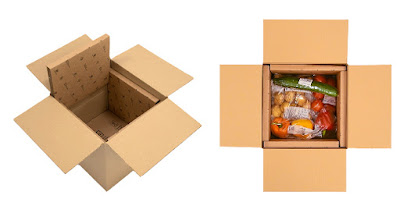What is Chilled Packaging?
Chilled packaging is a form of temperature-controlled
packaging that uses advanced insulation and cooling technologies to maintain a
consistent temperature range for perishable goods during transit. Unlike
traditional refrigerated transport, chilled packaging does not require bulky
and expensive refrigeration units, making it a more cost-effective and
environmentally friendly option for shipping temperature-sensitive products.
How does Chilled packaging work?
Chilled packaging works by creating a protective barrier
around the product, which prevents it from being exposed to external
temperatures that can cause spoilage. This packaging can be made of a variety
of materials, such as foam, cardboard, or plastic, and it is often combined
with cooling elements such as gel packs, dry ice, or phase change materials
(PCMs).
The cooling elements are carefully selected and placed
within the packaging to provide the optimal temperature range for the specific
product being shipped. For example, some products may require a temperature
range between 2°C to 8°C, while others may need to be kept at a frozen
temperature of -18°C.
Benefits of Chilled Packaging
·
Cost-Effective
One of the biggest advantages of chilled packaging is that
it is much more cost-effective than refrigerated transport. Traditional
refrigerated trucks and containers are expensive to purchase or rent and
require additional maintenance and fuel costs. In contrast, chilled packaging
is a one-time cost that can be easily customized and adapted to fit the needs
of different products.
·
Environmentally Friendly
Chilled packaging is also a more environmentally friendly
option for transporting perishable goods. Refrigerated transport emits
significant greenhouse gases due to the energy required to power refrigeration
units. On the other hand, chilled packaging does not require any external power
source and can be reused or recycled, reducing the carbon footprint of shipping.
·
Versatile
Chilled packaging is a versatile option that can be used to
transport a wide range of temperature-sensitive products, including food,
pharmaceuticals, and medical supplies. It can also be used for both domestic
and international shipping, making it a viable alternative for businesses of
all sizes.
·
Maintains Product Quality
Chilled packaging is designed to maintain a consistent
temperature range during transit, which helps preserve the product's quality
and freshness. This is especially important for perishable goods, such as fresh
produce, dairy, and meat products, which can spoil quickly if not kept at the
proper temperature.
Conclusion
Chilled
packaging is an innovative and cost-effective alternative to
traditional refrigerated transport for shipping perishable goods. By using
advanced insulation and cooling technologies, chilled packaging can maintain a
consistent temperature range for a wide range of products while reducing costs
and the carbon footprint of shipping. As more businesses look for sustainable
and cost-effective solutions for their shipping needs, chilled packaging is
becoming an increasingly popular option for transporting temperature-sensitive
products.

Comments
Post a Comment